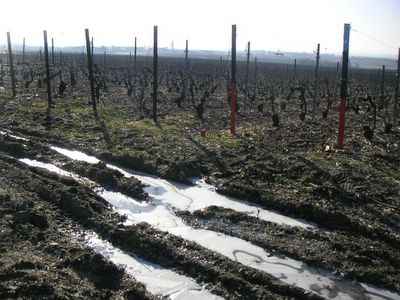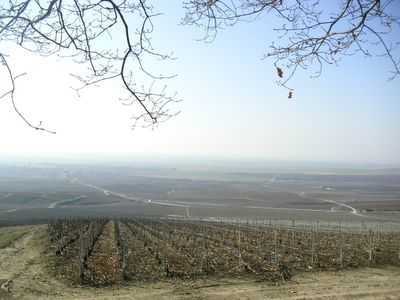
Vineyards in the outskirts of Rilly-la-Montagne in the Montagne de Reims. The capital of Champagne, Reims, can be seen in the horizon. The distance is less than 10 kilometres.
Spring has come to Champagne. The days at the moment boast clear and very blue skies.
The birds, that stay with us, have begun to build their nests and are singing along in the village as well as in the forest. Their travelling collegues are on the move far above our heads, with a course straight North. My thoughts are far away from avian flu. Instead they make me homesick.
I often hear them when I am in the vineyards. To work, to take photos or to stroll along. A great privilege to have such errands for hours in this great living room of nature.
The sun warms cold chins
It is still rather cold. In the morning almost freezing with temperatures round or below zero. The wind is cold, the air as well, but we clearly feel that the sun now gives battle against the forces of winter. It warms the chins, and I am quite convinced that winter now does not have the slightest chance of comeback.
After completing the eighth thursday at the pruning course in Avize, I even managed to return home with sunburnt chins. Never gave it a second thought to put sunscreen all along with my woollen sweaters, hat and gloves.

Frozen earth and puddles outside the village of Bouzy in the Montagne de Reims.
The vines are still lying dormant though. When we prune, we can see, that the time of tears - les pleurs - has not yet begun. That is fine, says cousin Nathalie, who has offered me private training in the company of her Pinot Meunier pruned cordon-style in the outskirts of Rilly-la-Montagne, another little winegrower's village on the northern slopes of the Montagne de Reims.
The tears of the vine reports the new season
The time of tears is a phenomenon, that begins, when the vine after lying dormant all winter begins to wake up for the next period of growth. As the tmeperature of the soil passes a certain degree, the concentrated sap inside the vine becomes fluid again and rises upwards, to reach the buds. If you prune the vine at this time, the sap will flow everywhere you cut as if it was an open wound. These are the tears of the vine.
The tears however are not bad for the plant. According to the pruning-course the best time to do your pruning is March. That is if it does not freeze more then 2-3 degrees the following night. Frost may expose the plant to damage. Few days after the pruning, the wound has heeled and will be able to resist damage.
Pantry of the rabbits
Nathalie has developped her own methods, and she is keen to share. As you remove the attachments of last year, you at the same time get an idea of the cordons and the shoots of the plant. You estimate if it is time to renew the vine and if so you do a lancement from last years rachet. Then you do three rachets - certainly not according to theory, where you are only allowed one.
But what is also not according to theory is that the vineyard of Nathalie is amongst the more popular playgrounds of little rabbits in Montagne de Reims. And the little beasts are not satisfied jumping around in the rows, they forage as well. Amongst their preferred food are the young buds of the rachets. Which is why Nathalie leaves two rachets with two buds and one with one bud. A little extra to be better safe than sorry.
I often pass this spot late in the evening, and it is quite true. No where between Rilly-la-Montagne and Verzy do I see more little rabbits fooling around than exactly these hills. It seems to be a really hot spot amongst rabbits.
It leaves Nathalie more work because once she has finished the pruning and the attaching she will have to do an extra trip to check all the vines to remove those of the extra rachets that were not necessary after all.

The tallest point in the Montagne de Reims (259 meters) is situated between the villages Bouzy and Louvois on the edge of the big forest, that covers the entire top of the Montagne.
Friday bar begins on thursdays
Thursday - day of the pruning course - more and more resembles what we in Denmark know as the bar of fridays. The beer(s) you enjoy with your friends to celebrate the end of the week and start of the weékend.
Today Damien has brought redwine, baguette and homemade patées of his mother-in-law for a casse-croûte before we begin. A couple of hours later - just before lunch - he serves champagne, a rose de saignée from the departement of Aisne, the extreme Western point of Champagne, and on top of that a blanc de blancs from Avize.
Now, I happen to like our own rosé de saignée very much with its wonderful deep pink colour and rich taste of red fruits, so I find it slightly difficult to reconcile myself with that of Damien. The taste is much less fruity and more dry. The grapes of Aisne are simply more sour, says Alain. However, the rosé wins an incredibly lot by being drunk with the little quiche-pieces of Florence and crips. It seems much more rounded and pleasant in salty company.
The other bottle of Damien - the blanc de blancs from Avize - is very pleasant on its own. Pure Chardonnay-champagnes sometimes seem too close to bubbly white wines, but this one is wonderful and arrives wonderfully smooth on your palate, a perfect aperitif. It certainly wins over our own non vintage blanc de blanc, which is more sour. However, if you like to have your taste buds challenged, our vintage blanc de blanc - Le Vertueux is the name - is probably more interesting. But then again it is not quite fair to compare a vintage with a non vintage champagne. They are just different.
The whole range of different champagnes in Champagne is a true treasury for your perceptions. If you enjoy this kind of challenge.
På dansk
Copyright: The copyright for text and photos at bobler.blogspot.com belongs to Solveig Tange. You may use my articles, photos or parts of them for non-commercial use and if I am credited as the author. Feel free to link to this site but not in your own frameset please.
No comments:
Post a Comment